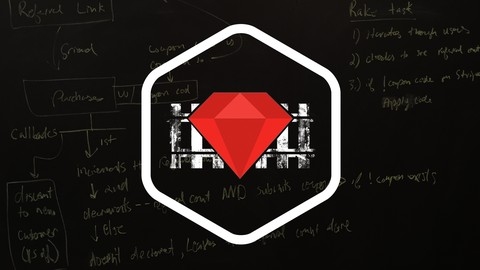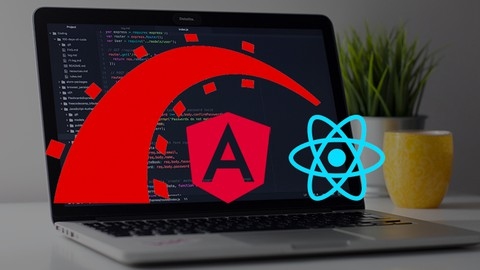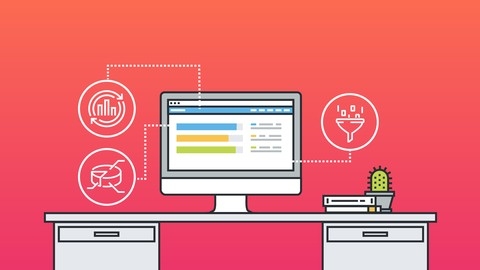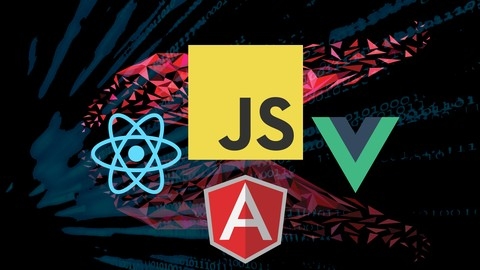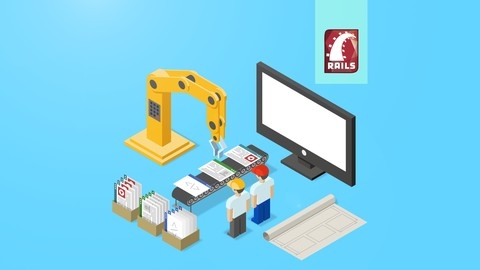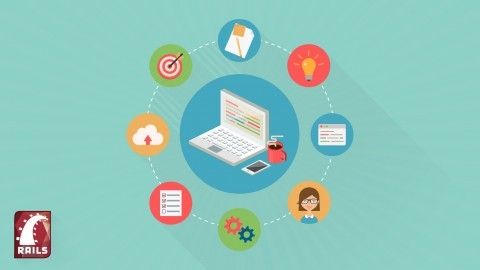The Complete Ruby on Rails Developer Course
You will start by learning the fundamentals of the Ruby programming language, including data types, control structures, methods, object-oriented programming concepts, and more.
This lays a solid foundation for understanding the Rails framework.
Once you have a grasp of Ruby, the course dives into the Rails framework itself.
You’ll learn about the Model-View-Controller (MVC) architecture, routing, controllers, views, and working with databases.
You’ll build several projects from scratch, implementing core features like authentication, associations, validations, and file uploads.
The course also covers integrating popular front-end frameworks like Bootstrap and Semantic UI for styling your Rails applications.
You’ll learn how to work with JavaScript to add dynamic functionality and make AJAX requests.
One of the highlights is building a real-time chat application using ActionCable and WebSockets, which demonstrates advanced Rails concepts.
You’ll also build a stock trading app that consumes third-party APIs and implements social features like friend tracking.
The course covers deployment to production environments, including setting up email services, payment gateways (Stripe), and file uploads using AWS.
You’ll learn how to work with environments, credentials, and secure your application.
Towards the end, you’ll build a project management app with subscription plans, inviting members, and uploading artifacts, showcasing the development of a Software as a Service (SaaS) application.
The course also includes sections on using alternative front-end frameworks like MaterializeCSS and guides you through setting up your development environment on different platforms like macOS, Windows, and AWS Cloud9.
Dissecting Ruby on Rails 5 - Become a Professional Developer
The course starts by guiding you through setting up your development environment on both Mac and PC, covering everything from installing essential tools like Ruby, Rails, Git, and databases to configuring code editors.
It then dives into core Rails concepts like creating a new application, implementing version control with Git and GitHub, utilizing generators to quickly scaffold code, and understanding data flow and routing.
You’ll learn how to build full-fledged features from scratch, such as authentication with Devise, authorization with Petergate, file uploads to AWS S3 using Carrierwave, and integrating JavaScript for drag-and-drop interfaces.
It covers more advanced topics like working with the Rails asset pipeline, integrating external APIs (e.g., Twitter), implementing live updates with ActionCable, and following best practices for production-ready applications.
You’ll also learn how to style your app using Bootstrap 4 and add custom fonts and icons.
Finally, you’ll deploy your application to Heroku, a cloud platform for hosting Rails apps.
The course even touches on the latest Rails 6 release, giving you a head start on the newest version.
You’ll learn by doing, implementing various features hands-on, while also diving deep into core concepts and best practices.
React JS + Angular + Rails 5 Bootcamp
You’ll start by learning how to architect an Angular application that integrates with a Rails API backend following a microservices approach.
The course walks through building an Angular front-end component by component, covering routing, views, data modeling, forms, validations, and integrating Bootstrap for styling.
You’ll then create a Rails API app to serve as the backend microservice for managing documents and proposals data.
The Angular app will consume this API data using observables and services.
The course covers core Angular concepts like components, services, routing, and observables in-depth with plenty of examples.
Next, you’ll build another front-end using React along with supporting tools like TypeScript, Webpack, and Babel.
You’ll learn React fundamentals like hooks, components, routing, forms, and creating custom hooks for responsive design.
The final section dives into authentication - building user registration, login, and logout flows using a Rails API and React front-end.
Throughout the course, you’ll integrate the different pieces, seeing how a modern full-stack app can be built using a microservices architecture with Angular/React front-ends and a Rails API backend.
You’ll build real-world features like sliding pane modals, dynamic notifications, email triggers, and more.
Basics of GraphQL with Ruby on Rails
This course starts by introducing you to GraphQL and how it differs from the traditional REST architecture.
You’ll learn about the key concepts like queries, arguments, and context, and how they relate to ActiveRecord in Rails.
The course dives deep into working with different data types in GraphQL, including scalars, arrays, and custom types.
You’ll also learn how to handle nullability, which is crucial for maintaining data integrity.
Once you’ve mastered reading data, the course moves on to teaching you how to change data with GraphQL.
You’ll learn how to create, update, and delete records using queries and mutations.
The course also covers input types and variables, which are essential for building dynamic and flexible GraphQL APIs.
One of the most important aspects of any web application is authentication and authorization.
This course covers these topics in detail, teaching you how to implement login and logout functionality, as well as how to control access to different parts of your application based on user roles and permissions.
Throughout the course, you’ll work with real-world examples and practical exercises, ensuring that you not only understand the concepts but also know how to apply them in your own projects.
By the end, you’ll have the skills and knowledge necessary to build robust and efficient GraphQL APIs for your web applications.
Ruby and Ruby on Rails Starter
You’ll start by setting up your development environment with an online IDE and learning the fundamentals of the Ruby programming language.
This includes working with strings, numbers, conditional statements, arrays, and hashes.
Once you have a solid grasp of Ruby basics, you’ll dive into object-oriented programming concepts like classes, inheritance, and modules.
The course culminates in a project where you’ll build a File Reader class, solidifying your Ruby skills.
The second half of the course focuses on Ruby on Rails, a popular web application framework.
You’ll learn about the Model-View-Controller (MVC) architecture and how to create a new Rails app.
The course covers essential web development concepts like views and CRUD (Create, Read, Update, Delete) operations.
To reinforce your learning, you’ll build a Todo app using Rails’ powerful scaffold generator and the Bootstrap front-end framework.
This hands-on project will showcase the productivity gains of Rails and give you experience with a real-world application.
Throughout the course, you’ll work with an online IDE like Cloud9, familiarizing yourself with the command line and development tools.
The course provides text directions, code examples, and assignments to ensure you understand each concept before moving on.
Ruby on Rails: Learn 25+ gems and build a Startup MVP 2023
You’ll start by setting up your development environment and learning the basics of Ruby on Rails.
Then, you’ll dive into building the core functionality of an e-learning platform, which serves as the main project.
Along the way, you’ll learn how to use over 25 popular Ruby gems like Bootstrap, Simple Form, Devise, Pundit, Ransack, Friendly ID, Action Text, and more.
One of the standout features is the focus on real-world skills.
You’ll learn how to handle authentication, authorization, roles, searching, filtering, pagination, and tracking user activity.
The course also covers integrating with external services like Stripe for payments, Sendgrid for emails, AWS S3 for file storage, and Google Analytics.
You’ll gain experience with advanced topics like nested resources, multistep forms, PDF generation, and integrating social logins with Google, GitHub, and Facebook using OmniAuth.
Additionally, you’ll learn how to prepare your application for production, including setting up a custom domain, SSL, sitemaps, and handling errors.
The course takes a hands-on approach, guiding you through building the e-learning platform step-by-step.
You’ll learn how to add features like course enrollment, progress tracking, ratings, and analytics.
The instructor also covers best practices for code organization, validation, and database design.
With its focus on building a real-world project, you’ll gain practical experience that can be applied to your own startup or development projects.
JavaScript and Ruby on Rails with React, Angular, and Vue
You will start by learning the fundamentals of JavaScript, including variables, operations, functions, and objects.
Then, you’ll dive into building interactive web pages with JavaScript and the Document Object Model.
The course covers Ruby on Rails, a popular web application framework.
You’ll learn how to create a new Rails app, define routes, work with models and databases, and build user authentication.
The curriculum includes several projects to reinforce your Rails skills, such as building a web app with CRUD functionality.
A significant portion of the course focuses on integrating front-end JavaScript frameworks like React, Angular, and Vue.js with a Rails back-end.
You’ll build real-world applications like a todo app, a blog platform, a finance tracker, and a task manager.
These projects will teach you how to set up the frameworks, create components, manage state, make API calls, and deploy your applications.
The course starts with React, where you’ll learn React basics, component lifecycle methods, and how to integrate React with a Rails app.
With Angular, you’ll build a portfolio app and a friends app, covering concepts like services, controllers, and API integration.
Finally, you’ll use Vue.js to create a task manager app, exploring features like computed properties, class bindings, and form handling.
Throughout the course, you’ll work with tools like Node.js, Yarn, and Webpacker to manage dependencies and build modern web applications.
The curriculum emphasizes hands-on learning, with coding exercises and detailed instructions for each concept and project.
Ruby on Rails Foundations
You’ll start by learning how to install Rails on your computer and create your first application.
The course covers the fundamental components of a Rails app, including the file system, console, routing, views, controllers, and models.
You’ll learn how to work with databases in Rails, including creating and modifying tables, adding validations, and setting up relationships between models.
The course also covers advanced topics like integrating Ruby gems, file uploads with Carrierwave, connecting to the AWS API, and implementing authentication with Devise.
One of the strengths of this course is its practical approach.
You’ll build several Rails applications from scratch, giving you hands-on experience with scaffolds, generators, CRUD operations, nested routes and forms, and integrating custom queries and algorithms.
The course also covers deployment, teaching you how to push your Rails app to GitHub and deploy it to Heroku.
You’ll learn how to access the Rails console on Heroku for debugging and maintenance.
Throughout the course, you’ll take quizzes to reinforce your understanding of key concepts like routing, views, controllers, models, and database management.
The course concludes with a comprehensive final quiz to test your mastery of Ruby on Rails development.
With its combination of theoretical explanations and practical exercises, this course provides a solid foundation for building modern web applications with Ruby on Rails.
You’ll gain experience with industry-standard tools and techniques, preparing you for real-world Rails development projects.
One-stop Ruby on Rails: Build Web Applications from Scratch
You’ll start by building a review and rating aggregator similar to Yelp.
The course walks you through installing Ruby on Rails, creating your first pages, and adding functionality like navigation bars and forms.
You’ll also learn how to work with images, integrate with Amazon S3 for image hosting, and implement user authentication with the Devise gem.
As you progress, you’ll add more advanced features like reviews, star ratings, and integrating with Google Maps and search functionality.
The course ensures you understand key concepts like validations, permissions, and nested resource URLs.
Next, you’ll build a two-sided marketplace like Etsy.
You’ll create listings, allow users to upload images using Paperclip and ImageMagick, and integrate with Dropbox for online image hosting.
You’ll also implement user authentication, associate listings with users, and set up permissions.
The course then covers building an order system, accepting payments with Stripe, collecting credit card and bank account information, and transferring funds between buyers and sellers.
Additionally, you’ll learn web scraping techniques to collect data from websites like Wikipedia and Airbnb, and store it in a CSV file.
You’ll also build an apartment rental site using the 3Taps API, scraping data, storing it in a database, and implementing advanced filtering options.
The course covers various other topics like adding social media integration, categories, pagination, internationalization for multiple languages and currencies, and performance optimization techniques.
Ruby On Rails For Web Development
The course starts by helping you set up your development environment, including installing essential tools like Node.js, Sublime Text, Git, and the Heroku Toolbelt.
You’ll learn how to create and manage projects, handle errors, and use version control with Git and BitBucket.
The course covers hosting your app on Heroku, a popular cloud platform.
As you progress, you’ll build a Pinterest-like application called “Pins.”
You’ll add pages, style them with Bootstrap, and implement user authentication with Devise.
The course teaches you how to associate data models, such as associating Pins with Users.
You’ll also learn to handle file uploads by integrating ImageMagick and Paperclip gems.
To store images, you’ll use Amazon S3, a scalable cloud storage service.
The course covers advanced topics like adding jQuery Masonry for transitions, pagination, and making your site mobile-friendly.
You’ll learn how to set up custom domains and subdomains on Heroku.
Throughout the course, you’ll work on a real-world project, gaining practical experience in building a full-featured web application from scratch using Ruby on Rails.


